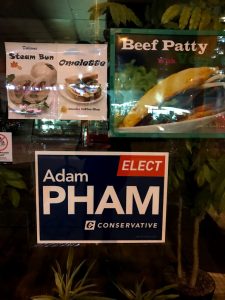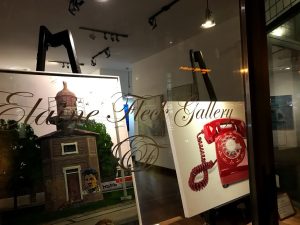Analyzing the built form in Little Tibet provides interesting clues about local residents’ religious and political beliefs. Firstly, there are seven religious institutions within the boundaries of Little Tibet. There are places for Baptists, Anglicans, Catholics, Presbyterians, and Bhuddists to practice their religions. These institutions are a key cultural feature of the enclave and indicate the religious diversity of the area. The Karma Sonam Dargye Ling Buddhist Temple is very important to Tibetans living in Little Tibet since Tibetan Bhuddism is the dominant religion of Tibet. 2.6% of all residents in High Park- Parkdale ethnically originate in China, and since Tibet is an autonomous region as part of China, Tibetans are included in this statistic (City of Toronto, 2018). Another prominent religious institution in the area is the Our Lady of Lebanon Maronite Catholic Church. As Allan Jacobs tells us, “Older public buildings help tell who the earlier development was for and who lives there presently: schools mean families with children; Catholic churches mean Catholic residents; Slovenian halls mean a Yugoslav community; fraternity houses are a signal of a university nearby” (1985). While the religious breakdown of High Park- Parkdale or of Little Tibet is not provided by census data, the proliferation of religious institutions indicates both the importance of religion historically and points to the wide range of religions practiced in Little Tibet.
The political diversity in Little Tibet is something which surprised me on my visits to the site. Jason’s Coffee Shop is considered another landmark within Little Tibet due to its central location, plethora of diverse food options, and the opportunity for engaging dialogues provided by its comfortable setting. As pictured in Figure 4, there were candidate signs in the window indicating support for the Conservative candidate for the current federal election, Adam Pham. This surprised me because High Park-Parkdale has voted liberal in all but three of the thirteen federal elections since 1979 (Adam Swimmer, 2019). What’s more, in the rest of Little Tibet the candidate signs showed support for the Liberals, New Democratic Party or the Green Party. It struck me as interesting that a site where an exchange of ideas is openly encouraged and where so many cultures are represented through food would support a Conservative candidate.
Cafes like Jason’s Coffee Shop and restaurants provide important meeting spaces for political events. This doesn’t point to a lack of more official meeting locations in the enclave, but rather that these places are nodes for local Tibetan residents. They are unique, well-known, easily accessible and also offer the opportunity for passersby to participate. This is precisely what happened to me on one of my walks of the enclave. As I passed by the Norling restaurant on Queen Street West one evening, I noticed a large group of people inside and someone speaking into a microphone. As I peered in, I was invited to enter the space by a Tibetan woman and was given an ‘Arif Virani’ support sticker. I had stumbled across a political rally by Varani, who as of October 22 has retained his seat as the federal Member of Parliament for High Park- Parkdale.
There are several fascinating points to take from this event. Firstly, it’s an example of how civic culture bridges the private and public domain, in that the behaviour of an ethnic group is modified by politics and voting as a civic duty (Quadeer, 2016). It’s an opportunity for immigrants to, as Quadeer puts it, consider their rights and responsibilities as Canadian citizens (2016). Introducing the political process and presenting the views of politicians can help immigrants participate in Canada’s political system and develop their views on the issues raised.
Secondly, Quadeer also tells us that having minorities in political positions help integrate their interests into the common ground (2016). Varani is a refugee and an immigrant himself, originally hailing from Uganda. The two-way process of integration is thus abundantly clear; politicians speaking to residents in Little Tibet can help acculturate them to political issues in the local context and politicians like Varani are also able to listen and act on the issues and interests raised by local immigrants. Finally, Varani spoke in English but enlisted the help of a translator to translate into Tibetan. This move recognizes unique needs of the community and is an example of reasonable accommodation; since Varani was the incumbent MP in the riding, this move can be seen as a federal representative recognizing cultural differences while preserving civic order and institutional unity (Qadeer, 2016).
As a final note on this experience, as a visitor to both Little Tibet and as a white person, I felt out of place at this political event and soon left. Not being Tibetan, I would have felt uncomfortable participating in the songs or eating the Tibetan food offered for free at the event (see Figure 5). Interestingly, the woman who first invited me in gave me quite a critical glance on my way out, as if to critique me for leaving. Yet it was clear to me that this event was not for me. Events like this remain a critical part of Toronto’s ethnic landscapes to support immigrants to Canada.
So, where is Little Tibet now, and where will it go in the future? I have argued that there are certain key features of the enclave, restaurants and schools, religious institutions and locations for political meetings which serve to accommodate Tibetan people. Restaurants allow Tibetans to show their pride while remaining outside of politics if they wish to and provide employment opportunities. Religious institutions in Little Tibet point to the history of the enclave and also serve the needs of both Tibetan and non-Tibetan residents. Political events and discussions often take place in informal environments like cafes and restaurants. Promoting immigrants’ inclusion in politics as politicians and as the public can be a tool to support multiculturalism. It works to bridge the public and private domain, and supports the idea that integration is a two-way process. However, every enclave is always shifting. Little Tibet is beginning to gentrify; Glory Hold Doughnuts and the Elaine Fleck Gallery (see Figures 6 and 7) are two examples of this. These doughnuts and artwork do not take into account the local Tibetan culture nor the low incomes of High Park- Parkdale residents. Retaining institutions which support the ethnic, religious, and political diversity of Little Tibet will be critical to its survival in the future.

Figure 4 – A Conservative candidate federal election sign
Figure 5- A sound clip taken of music being performed at the Arif Varani rally

Figure 6 – The entrance to Glory Hole Doughnuts, an example of gentrification

Figure 7 – The Elaine Fleck Gallery, an example of gentrification
List of Figures
Figures 4-7: Photographs and an audio clip taken by the author
References
City of Toronto. (2018). City of Toronto Ward Profiles, Ward 4: Parkdale- High Park. Toronto: City of Toronto, https://www.toronto.ca/wp-content/uploads/2018/09/8f6b-City_Planning_2016_Census_Profile_2018_25Wards_Ward04.pdf.
Jacobs, A. (1985). Clues. In Looking at Cities (1st ed., pp. 30-83). Cambridge: Cambridge University Press.
Qadeer, M. (2016). Multicultural Cities. Toronto: University of Toronto Press.
Swimmer, A. (2019). PARKDALE-HIGH PARK: Liberal MP Virani holds onto seat. Toronto Sun. Retrieved from https://torontosun.com/news/national/election-2019/parkdale-high-park-liberal-mp-virani-fights-to-hold-onto-seat
